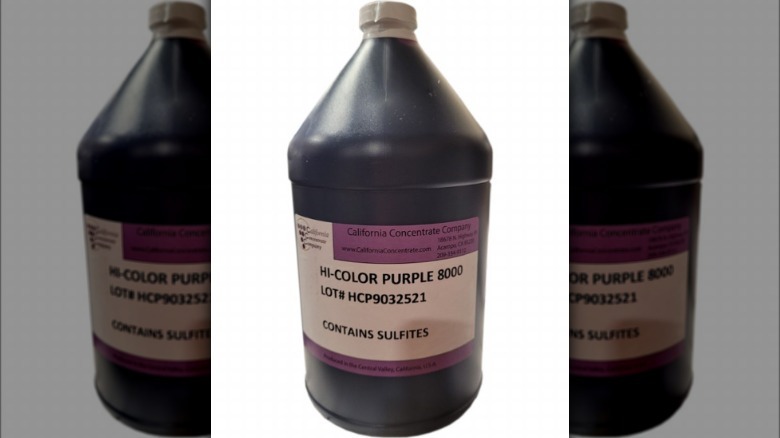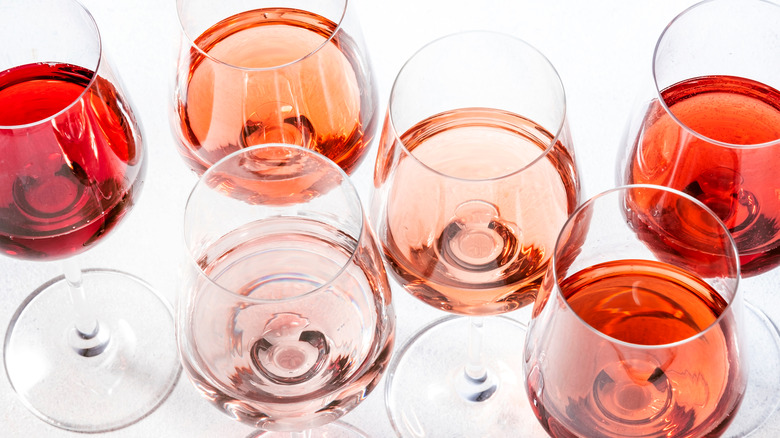What Is The Mega Purple Additive In Wine?
As much as we might like to believe that the gentle rosés and hearty burgundys that line store shelves are no more than aged grapes, the truth is slightly more complicated. The cops on the beat — the FDA and the Alcohol and Tobacco Tax and Trade Bureau — restrict the use of the great majority of potential artificial additives and colorants, with the exception of: FD&C Yellow No. 5, cochineal extract, and carmine.
According to these government agencies, wines containing artificial colorants will disclose that fact on the label. But there are some additives — known to insiders as Mega Purple (and the lesser used Ultra Red) — that winemakers can include in bottles without needing to disclose the fact. The answer as to why gets into how wine is both made and marketed, and also how much consumers really care about knowing everything that goes into a bottle of wine. If you get a couple of winemakers or even passionate wine enthusiasts together, the words "Mega Purple" are likely to induce eye-rolls, provoke arguments, and possibly both.
What is Mega Purple?
Before we can go down the Mega Purple rabbit hole, it's important to know where the color in wine traditionally comes from. Prior to modern advents, a wine's color came from the skins and sometimes the flesh of the grapes used in its production. Red grapes contain anthocyanins, which naturally color red and rosé wines, and, according to wine purists, that should be the end of the story.
But, of course, it isn't. This is because many red wine drinkers equate value and flavor with the depth of color in wine — even though some of the world's greatest red wines are made from Pinot Noir, which is typically much paler than a Cabernet Sauvignon, for example. And since wine's an agricultural product — meaning that some vintages produce grapes that may be less concentrated in color — even Cabernet producers may be disappointed in the color of a given vintage. (If only there were something a winemaker could add that would deepen the hue.)
Enter Mega Purple. Mega Purple is a rich, syrupy grape juice concentrate that winemakers can add to a wine to bump up the color, texture, and sweetness. It's typically used in small amounts, and while some critics sneer at it as a cheap additive used to prop up cheap wines, its use is far more common than most wine drinkers realize.
Why does Mega Purple matter?
Because Mega Purple is a natural ingredient (also from grapes), it doesn't have to be disclosed on a label of red or rosé wine that contains it. And its use differs little from the convention of blending wines, as Pinot producers have done for years using varieties like Syrah to deepen the color of their product.
What many take issue with is that part of the romance of (particularly high-end) wine, is that they like to think of it as a unique product — a reflection of its terroir and the soul of a vineyard. Additives like Mega Purple and its cousin, Ultra Red, can — if used in anything other than the tiniest of quantities — homogenize wines. They can make a $100 bottle of Napa Cab from Calistoga appear (and possibly taste) the same as a $100 bottle from Oakville. Or worse, it can make a $12 bottle of red wine look more robust than it actually is.
So the longer answer about artificial color in wines depends on how you define "artificial." If your concern is avoiding certain chemicals, that answer should be on the bottle, as it's a required disclosure. But if you're curious about whether the color in the bottle came solely from a specific vineyard, you may have to persuade winemakers to spill their secrets or ... lawmakers to persuade them.


